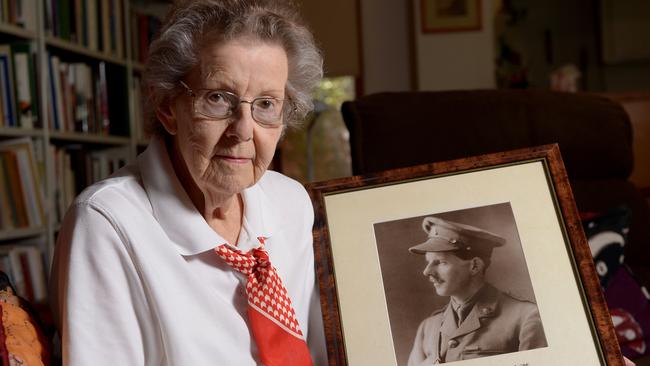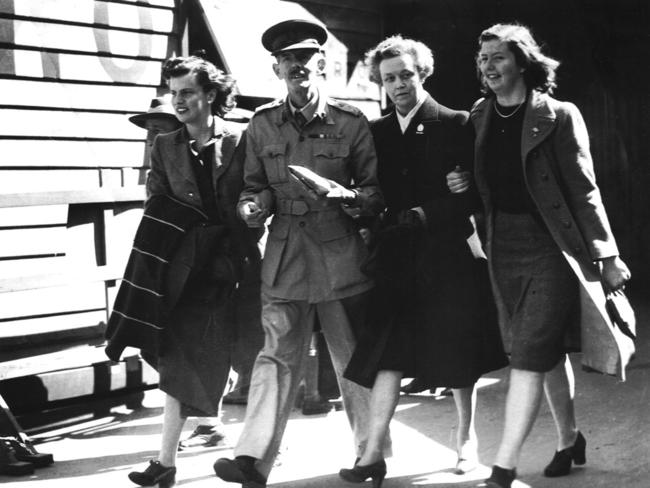Blackburn’s leadership and bravery made him one of SA’s greatest heroes in both world wars and epitome of Anzac spirit
Arthur Blackburn didn’t look like a typical Aussie digger but the skinny young lawyer became the first South Australian to win the Victoria Cross for his bravery and leadership in WWI.

National
Don't miss out on the headlines from National. Followed categories will be added to My News.
ARTHUR Blackburn did not look like a typical Aussie Digger, but the skinny young lawyer from Woodville would became the first South Australian to win the Victoria Cross for his bravery and leadership in World War I.
During the bloody trench warfare on the Western Front, Blackburn captured almost 400 metres of German territory after leading assaults at Pozieres, France, in 1916.
He was awarded the Victoria Cross for his role in the battle — the pinnacle of his distinguished life as a soldier in two world wars, including Gallipoli, and as a politician.
Pozieres was an important point in the German line on the Western Front, and its capture was seen as crucial in protecting any future British advance.
Blackburn’s achievements on the battlefield at Pozieres is the stuff of legend.
He led a group of 70 men in eight attacks on sections of the German trench line.
After a day of fighting, about 40 of his soldiers were wounded or killed.
Blackburn survived uninjured, despite being involved in every major foray and leading the attack from the front under heavy machine gun fire and German mortars.
The soldiers he commanded in World War II shared their devotion to the man they called “Blackie” in his biography, Arthur Blackburn, VC, by Adelaide journalist Andrew Faulkner.
“I think Blackie was a wonderful fellow,” Lanie Greer of the 2/3rd Machine Gun Battalion said in the book.
“He didn’t get the VC for nothing. If he wanted to go to the frontline he went there — he wasn’t frightened.”
Banjo Binstead, also of the 2/3rd Machine Gun Battalion, said: “Blackie was a marvellous officer. I don’t think anyone said a bad word about him.”
Faulkner said Blackburn’s actions on the battlefield at Pozieres were remarkable.
“When you consider that he led a group of about 70 men and more than half of them were injured or killed but he was unharmed, and he led from the front, it is truly incredible,” Faulkner said.
“He obviously had a great sense of determination but he was also greatly respected by his troops.
“On the most part, Australian officers had a similar upbringing to the troops and there was a spirit of egalitarianism.
“I think Blackburn was the epitome of that.”

Faulkner said Blackburn was one of the country’s greatest war heroes.
“What he did in two world wars was truly remarkable but I don’t think he gets the recognition he deserves.”
King George V presented Blackburn with the Victoria Cross at Buckingham Palace on October 4, 1916.
Blackburn returned to Adelaide in December that year.
He was also one of the first Anzac troops to land at Gallipoli in 1915, and he and a comrade were credited with reaching the farthest point inland.
The fighting for the first few days after the landing was intense.
Blackburn wrote in his diary all the Anzac troops knew surviving the first couple of days at Gallipoli would be “touch and go”.
Born in Woodville, on November 25, 1892, Blackburn was the youngest of four children to the reverend Thomas and Margaret Blackburn.

He started school at Pulteney Grammar in 1903, before switching to St Peter’s College in 1906. He graduated with a law degree from the University of Adelaide in 1913.
Despite completing his studies and commencing a new career, Blackburn enlisted to fight in World War I in August, 1914.
After basic training with the 10th Battalion he was shipped out to Egypt.
He married Rose Kelly, in March 1917, and was discharged from the army three weeks later.
The couple had four children.
Margaret Forbes, 85, Blackburn’s last surviving child, said her father was remarkably brave but did not look like a war hero.
“He was quite skinny and had slim legs and knobbly knees but he had an amazing sense of determination,” Mrs Forbes said.
“As I have gotten older, I’ve realised what a remarkable man he was.”
Mrs Forbes said the family rarely discussed his war service or his honours.
“My father was a very mild-mannered man and he was devoted to the family, so we never really discussed the VC or the war.”
After World War I, Blackburn returned to legal practice and was president of the SA branch of the RSL between 1917 and 1921.
He served as an MP in the South Australian Parliament between 1918 and 1921.
After World War II broke out, Blackburn re-enlisted in the army and fought in Syria in 1941 in command of the 2/3rd Machine Gun Battalion.
Blackburn and his men were then sent to help defend the island of Java, but his forces were forced to surrender to Japanese troops in March 1942 and he spent the rest of the war in a prison camp.
It wasn’t until September 1945 that Blackburn arrived back in Adelaide.
Blackburn died of natural causes on November, 24, 1960.
He is buried in the AIF Cemetery on West Tce.
Originally published as Blackburn’s leadership and bravery made him one of SA’s greatest heroes in both world wars and epitome of Anzac spirit


